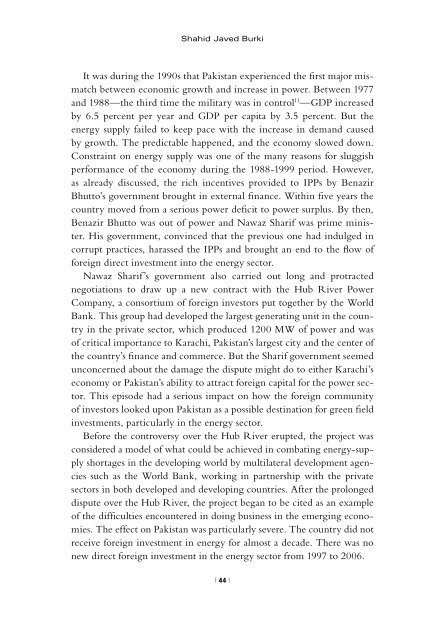fueling the future - Woodrow Wilson International Center for Scholars
fueling the future - Woodrow Wilson International Center for Scholars
fueling the future - Woodrow Wilson International Center for Scholars
- No tags were found...
You also want an ePaper? Increase the reach of your titles
YUMPU automatically turns print PDFs into web optimized ePapers that Google loves.
Shahid Javed BurkiIt was during <strong>the</strong> 1990s that Pakistan experienced <strong>the</strong> first major mismatchbetween economic growth and increase in power. Between 1977and 1988—<strong>the</strong> third time <strong>the</strong> military was in control 11 —GDP increasedby 6.5 percent per year and GDP per capita by 3.5 percent. But <strong>the</strong>energy supply failed to keep pace with <strong>the</strong> increase in demand causedby growth. The predictable happened, and <strong>the</strong> economy slowed down.Constraint on energy supply was one of <strong>the</strong> many reasons <strong>for</strong> sluggishper<strong>for</strong>mance of <strong>the</strong> economy during <strong>the</strong> 1988-1999 period. However,as already discussed, <strong>the</strong> rich incentives provided to IPPs by BenazirBhutto’s government brought in external finance. Within five years <strong>the</strong>country moved from a serious power deficit to power surplus. By <strong>the</strong>n,Benazir Bhutto was out of power and Nawaz Sharif was prime minister.His government, convinced that <strong>the</strong> previous one had indulged incorrupt practices, harassed <strong>the</strong> IPPs and brought an end to <strong>the</strong> flow of<strong>for</strong>eign direct investment into <strong>the</strong> energy sector.Nawaz Sharif’s government also carried out long and protractednegotiations to draw up a new contract with <strong>the</strong> Hub River PowerCompany, a consortium of <strong>for</strong>eign investors put toge<strong>the</strong>r by <strong>the</strong> WorldBank. This group had developed <strong>the</strong> largest generating unit in <strong>the</strong> countryin <strong>the</strong> private sector, which produced 1200 MW of power and wasof critical importance to Karachi, Pakistan’s largest city and <strong>the</strong> center of<strong>the</strong> country’s finance and commerce. But <strong>the</strong> Sharif government seemedunconcerned about <strong>the</strong> damage <strong>the</strong> dispute might do to ei<strong>the</strong>r Karachi’seconomy or Pakistan’s ability to attract <strong>for</strong>eign capital <strong>for</strong> <strong>the</strong> power sector.This episode had a serious impact on how <strong>the</strong> <strong>for</strong>eign communityof investors looked upon Pakistan as a possible destination <strong>for</strong> green fieldinvestments, particularly in <strong>the</strong> energy sector.Be<strong>for</strong>e <strong>the</strong> controversy over <strong>the</strong> Hub River erupted, <strong>the</strong> project wasconsidered a model of what could be achieved in combating energy-supplyshortages in <strong>the</strong> developing world by multilateral development agenciessuch as <strong>the</strong> World Bank, working in partnership with <strong>the</strong> privatesectors in both developed and developing countries. After <strong>the</strong> prolongeddispute over <strong>the</strong> Hub River, <strong>the</strong> project began to be cited as an exampleof <strong>the</strong> difficulties encountered in doing business in <strong>the</strong> emerging economies.The effect on Pakistan was particularly severe. The country did notreceive <strong>for</strong>eign investment in energy <strong>for</strong> almost a decade. There was nonew direct <strong>for</strong>eign investment in <strong>the</strong> energy sector from 1997 to 2006.| 44 |
















